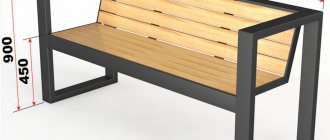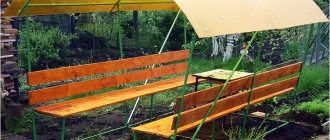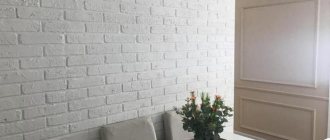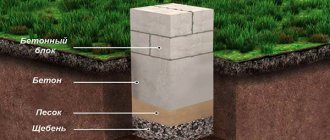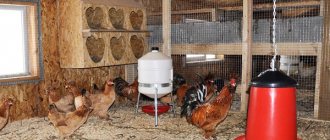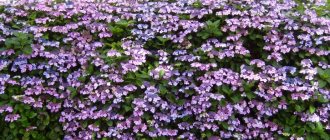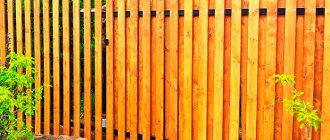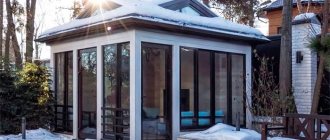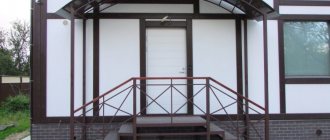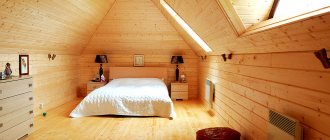Types of benches
There are many types of benches. The master brings something special and unusual to the appearance of this simple element for the garden. However, all models can be divided according to some common characteristics.
Benches without backrest
This type is considered the simplest, as it consists only of a seat and several supports. Only this can all be implemented in different ways.
- We have before us a reliable, but not very attractive solution. However, the creator of this design still provided for a certain asymmetry - one edge of the seat protrudes beyond the legs, and the other is level with them. The bench is made of thick integrated boards and laminated veneer lumber. Externally, the material is roughly processed. This bench is suitable for many rustic styles, such as American country.
Simple wooden bench without back
- This bench is made of wood and concrete was used for the supports. Such composite structures look good in many landscape design styles, for example, high-tech, minimalism or loft. Concrete parts have clear geometric shapes. Against their background, the varnished board contrasts perfectly and looks very advantageous. Such a bench will also be very stable, but extremely heavy - moving it to a new place will be difficult.
Concrete wooden bench legs
- The back of this model is purely symbolic, so we will assume that it does not exist at all. It is not clear whether it will be comfortable, but it definitely looks impressive. Frame type construction. The basis was steel strips, which were looped and sheathed with a narrow lath. For stability at the bottom, additional stops are welded from a steel corner.
Outdoor benches made of metal and wood
A common disadvantage of benches without a back is the inability to completely relax while resting. You have to either keep your back tense, or create support with your hands on the seat or legs.
Benches with wooden backs
These models have a complicated structure, but they are more pleasant to relax on.
- A master of his craft clearly put a lot of effort into this model. The building material used was wooden beams, unprocessed branches and boards, which were given a rounded shape. All lumber is treated to appear aged and untreated by man. The absence of right angles and straight lines hints at unity with nature. Even the seat itself is slightly rounded inward along a wide radius.
Wooden bench with backrest for 2 people
- To achieve an aged effect, the wood is brushed. All soft fibers are removed from the surface of the material. This reveals its internal structure. A beautiful relief remains, which is further emphasized when processed with paints and varnishes or during firing. On this bench there are brushed boards in a composition with raw cuts of the trunk.
A trunk cut was used for the backrest
- Such designs are not suitable for every garden. Some styles value lightness and grace. An example of such a shop is shown in the photo below. The bench is clearly of factory origin, but if you have the right tools, you can do something like this yourself. In the photo there is clearly a lack of flowering vegetation around the bench.
Lightweight bench made of treated lumber
Assembly of such benches is also not the most difficult. Next, drawings will be presented and methods for their implementation will be described.
Bench with table
Such seats are installed mainly on terraces (read the article about arranging a terrace in a dacha), verandas and gazebos. The combination of furniture pieces forms the finished dining area.
- The photo shows an option for children. The tabletop is mounted on trusses with widely spaced legs. Crossbars are installed across them, to which the suspended bench seats are attached. Such a bench does not require a lot of material; its design is quite simple. In this case, the parts are securely connected to each other.
Wooden garden tables and benches for children
- These benches will withstand more serious loads, since they are not transferred to the table body, as in the previous case - the base under the structure is loaded. In fact, we see three separate objects connected at the bottom by a common strap. This solution gives stability to the thin legs of the bench. The seats and table top are made in an interesting way - a neat frame is formed from the board, the inside of which is filled with flooring. It looks very neat and beautiful.
How to make a wooden bench with a table for 4 adults
- The next model is complicated by the fact that it has backrests. The seats are held in place by common jumpers. It will be awkward to sit down and leave such a table. And if you consider that a backrest has also been added, then the options for this are even more limited.
These wooden benches have comfortable backs
. In general, the inconvenience of placement is a drawback of all such structures. Different people have their own sizes, so hosting guests at such a table can be a bad decision. Also, these beautiful wooden benches require a large and flat area for installation, so they are rarely placed on the ground.
Bench-sofa
This is the same bench with a back, but there are design differences. Firstly, soft pillows are always laid on top of the seat and under the back, secondly, they are made lower and are not placed in front of the dining tables, and thirdly, the seat is made deeper so that you can literally lounge on it.
- Like the previous option, these benches, due to their large dimensions, are installed on spacious terraces. This sofa is made from sanded and varnished boards. The pillows are stuffed with several layers of foam rubber and have removable covers so they can be washed (read the article on how to make pillows for garden furniture).
Bench-sofa corner
- Such structures usually have angular shapes, so processed timber of the correct cross-section is used for their manufacture. They do not differ in elegant shapes, so assembly will not be difficult - it is enough to build a strong frame, which is then covered with boards. These sofas look good in new style gardens.
Sofa with closed sides
- Old pallets are suitable as the main material for such a sofa - their shape and design correspond to the style of similar structures. Furniture made from pallets is a godsend for a loft-style garden. This material is inexpensive and very durable.
Garden benches - photos
But as for the shape of the bench, now there are many of them and you can choose any one to suit your taste. Let's say there is a huge spreading tree with a wide trunk growing in the garden. You can install a round bench around it so that those sitting have their backs to the tree trunk. But if you build a beautiful round flower bed or a small fountain, then a round bench will fit perfectly there, only those sitting will already be facing the center of the composition. Round benches are very convenient because they can accommodate many people without taking up much space.
Anyone who has installed a bench, or even several, in their garden can say with confidence that they have received another unique room, a cozy corner of their home, in which it is always pleasant to relax and spend time with loved ones. The only difference is that this corner is open air.
Materials for making benches
We have already seen what materials are used for garden benches, but there are no specifics yet. In this chapter we will analyze everything point by point.
| Material, photo: | Description: |
Treated lumber | Available in the form of slats, boards and beams. All this is used in structures of different sizes and complexity. Selecting the type of wood, the correct cross-section of parts and proper processing of materials allows you to create strong benches. Glued and bent wood is a separate category. This material is incredibly durable, moisture resistant, and does not deform due to changes in humidity. |
Benches for summer cottages made of metal and wood | Wood combines beautifully with metal, which is known for its durability. The frame of the structure is most often made of iron, which is covered with wood, but there is another option when only metal inserts are used as decoration of the product. The structures are assembled from various parts. Are used:
Benches with forged inserts look very nice (options of forged garden furniture are presented in our article). |
Block piece material | The base of the bench can be built of brick, or these hollow concrete blocks. The last option is considered the easiest to implement. In the photo on the left you can see that the blocks are simply folded into certain shapes, and the timber is inserted into the voids in them. To prevent the bench from being flimsy, it is better to tie the materials together. The brick base is placed on the mortar - it will be very reliable. This bench will be stationary. |
Hand-cut bench made from solid logs | Uncut wood is also often used for benches. These include driftwood, branches, and logs. Log models are extremely difficult to make, since you have to work with solid wood, precisely adjusting the gaps of the parts. It is difficult to do this without proper experience. Such benches are suitable for many national styles of Europe and Russia (you can see options for furniture made from logs at the link). |
Pallet bench | We included furniture made from pallets in a separate category, since they are used containers and are already put together according to a certain principle. On our website there is a separate article on garden furniture made from pallets, be sure to read it. |
The work can also use concrete, natural stone, metal mesh, hemp, logs and much, much more. Products made from other items look interesting. An example of this is shown in the following photo.
Bench supports from cart wheels
Garden bench materials
Modern benches are made from both classic materials - wood, stone, wrought iron, marble, and more modern ones - plastic, synthetic fiber. Often benches can be made simultaneously from two or more materials - stone and iron, wood and glass, forged steel and wood. The style in which this item is made depends on this. This means that it is necessary to select a bench for the garden taking into account its stylistic features. For example, a bench made of stone or forged steel and wood will fit perfectly into a garden designed in a classic style, and a bench made of plastic will look great on the lawn in front of a cottage in a modern style.
But still, the most popular material used to make a garden bench is wood. In particular, teak is most often used. Teak wood has always been used in shipbuilding because it is very resistant to moisture. In the fresh air, a gray coating appears on teak furniture, which can be easily removed with a soft brush. In addition, teak furniture must be treated with teak oil, which comes with the furniture, so that the furniture will last for many years.
Manufacturers of garden furniture often do not limit themselves to the production of just benches, but produce entire ensembles of garden furniture. In addition to benches, it includes a table, chairs, swings, chests for storing pillows - and all this, made in the same style, will be an amazing decoration for any garden.
Do-it-yourself benches for a summer cottage made of wood
Now let's talk a little about making such pieces of furniture. Let's look at two options.
Wooden bench without backrest
Basic parts of a simple form.
For work you will need the following materials:
- 4 boards with a section of 80*30 mm, length 1500 mm
- One beam with a cross section of 70*40 mm of the same length.
- Two 40 cm pieces of 40*30 mm timber.
- Glued board measuring 1000*1000 mm or larger, 40 mm thick - shaped supports will be cut from it.
Finished drawing of a wooden bench
All parts will be fastened with self-tapping screws.
- To begin with, a template is made from a sheet of cardboard that follows the shape of the legs of the bench (you can develop your own design).
- The shield is marked on it - two identical parts are needed.
- The edges of the workpieces are sanded and rounded with a milling cutter to add beauty.
- Next, a rectangular hole with a cross section of 70*40 mm is made in them, and the corresponding beam is hammered into them. The parts fit tightly and can additionally be joined with PVA glue.
- A short block of wood is placed on top of the posts to create a wider support for the flooring.
- The boards for the seat are mounted with a certain indentation.
Wooden bench with backrest
Again, the complexity of the job will depend on the type of structure.
Drawing of a wooden bench with dimensions
Do-it-yourself wooden bench drawings
A very clear and fairly simple plan. It indicates the dimensions of all parts and shows their shape. Despite the fact that the structure has a curved appearance, it is assembled from a rectangular beam and slats. There is not enough information on the type of fastener, its dimensions and installation points, although all this can be modified yourself.
Bolted connections will hold the best quality. Options for dowels, grooves and ridges are also reliable, but without being a carpenter, you won’t be able to make them well. Also, feel free to use stainless steel self-tapping screws - they are durable and not subject to corrosion.
Tools and materials
Consider creating a wooden bench from rough lumber. It is characterized by irregular geometry (when drying, the wood warps), the presence of knots, cracks, bark, and sometimes mold. All this requires appropriate processing to bring the material into proper condition.
The entire bench will be assembled from a board of the same section - 100 * 40 mm.
Draft board
Consumables you will need:
- Wood glue.
- Decorative and protective impregnation.
- Self-tapping screws.
- Nails.
To finish such lumber you will need the following set of tools:
| Tool, photo: | Description: |
Reismus | It has two cutting shafts that plan the board on both sides at once. A plane can be used as a replacement, but this will not provide accuracy in calibrating the parts. Thicknesser, when running boards through it, makes them even, removing “helicopters”, “boats” and other types of curvatures. With its help, the boards are given the same thickness without errors. |
Sander | After thicknessing, the surface of the boards becomes smooth, but not so smooth that the material should be left in this form. A grinder with fine abrasive will bring the surface to perfection. It will also allow you to smooth out the corners, although it is better to use a router for this work. |
Miter saw | The flowerpot will consist of many pieces of board. It is difficult to cut, and even accurately, by hand - this requires a miter box and a lot of free time. It is much easier and better to work with a miter saw. She makes cuts at different angles, depending on the settings. |
Screwdriver | You won’t have to tighten a lot of screws, so you can get by with a screwdriver. In addition to screwing fasteners, a screwdriver is also used for drilling holes. The tool will become the main one if nails are abandoned in favor of screws. |
Nothing stands out from the rest of the set:
- Tape measure, carpenter's square, pencil.
- Hammer.
- Brush for applying impregnation.
To accurately mark parts, it is recommended to use a metal ruler and a sharpened pencil.
Lumber processing
The following are step-by-step instructions for processing the board and preparing it for installation:
- The work begins with marking the boards - using a tape measure we mark the step, taking into account that the uneven end will have to be sawed off. If the cut is made on a miter saw, there will be no need to mark lines along the square - small points will suffice.
- The board is cut exactly according to the marks. There will be a lot of segments. In order not to return here due to a lack of blanks, we advise you to draw up a small drawing in advance and calculate everything exactly. Everyone is free to choose the sizes themselves, according to their own dimensions and needs.
Cutting the boards with a miter saw
For ease of storage, the boards are stacked.
It's hard to cut that much by hand.
- The thicknesser is being adjusted - you need to set the thickness of the produced board. You will have to remove 2-3 mm from the rough lumber on each side.
- Next, the bars are inserted into the apparatus, and processing occurs. The process is short and simple, but safety precautions are required. The boards are processed both in thickness and width. When running boards in width, it is allowed to pass 3-4 parts at a time. The work is streamlined - one person supplies rough lumber, and the second receives processed lumber. The thicknesser throws out a lot of sawdust, so you need to install a collection container.
A tool with a powerful motor can process two boards at a time
- All boards are processed with a sanding machine. Those parts that will face the inside of the flowerpot can be left unpolished. Attention should also be paid to the ends of the parts, since the edges, even when cutting with a miter saw, are covered with fringe. For convenience, the machine is placed on the table, on a pre-made stop. This technique is shown in the next photo.
The machine is tied to the table with a metal perforated tape
- The wood is treated with impregnations, which use oils, stains, and glazes. In the example under consideration, solvent-soluble wood oil “Tikkurila” was used. It is necessary to provide places for drying workpieces - there are a lot of them. The process takes time, depending on the type of material - detailed information is indicated on the label. The paintwork is applied in several layers with intermediate drying.
The process of applying oil impregnation
The use of oils is good because they penetrate into the thickness of the material, creating deep protection against moisture. They change the color of the wood, do not form a film on the surface, do not get dirty or crack over time.
Find out from the article on our website: how to paint a wooden bench.
Bench assembly
The hardest part of the job is over. What remains is the installation, which consists of forming flowerpots and seats, and connecting them into one structure.
The boards will not be laid solidly, but in order, with overlap. This will leave the contents of the flowerpot visible, so you will have to install an additional container inside. Before laying the boards, the edges are coated with PVA glue.
PVA glue will strengthen the connection many times over
Then a new row of material is placed on top and nailed into place. In the example, the technician uses an air gun connected to a compressor. In the absence of one, a hammer will do.
For reliable fastening, 3-4 nails are enough
If installation is carried out using self-tapping screws, then before screwing in it is necessary to drill holes of a smaller diameter. This will prevent the wood from cracking from internal stress.
The seat is assembled from 4 boards, on the edges of which jumpers will be screwed from below, which will rest against the frame of the flowerpot. They are set exactly from the edge at the same distance so that symmetry is maintained.
Jumper installation
First, glue is applied under the jumper, and then it is screwed onto self-tapping screws - two to each board.
The length of the screw is calculated so as not to damage the front side
The ends of the seat are sanded and a small chamfer is made to make it easier to insert the element into the hole in the flowerpot. Assembly can also be carried out in parallel - install the seats at the desired level, and then continue assembling the flowerpot.
Processing the ends of the boards
The bench is ready. Flowers are planted in flowerpots, after which the product takes on the following appearance.
Ready-made bench with flower pots
Despite the technical simplicity of the design, the result was an attractive composition. The oil gave the wood a noble shade. Such a bench will definitely not go unnoticed.
25 photos: interesting ideas for benches with flower beds
How to process wood
Since many tree species are not “friendly” with a humid environment that causes rot, products used outdoors must be carefully processed. Such protection will also protect against exposure to ultraviolet radiation, from which the material can fade and change its true color. Finishing is also done to transform the appearance of the wood. To do this, take the following compositions:
- Colored opaque paints that completely hide the wood texture. Various compositions are used, from which we want to highlight acrylic-based options. This material creates a durable and long-lasting coating. It comes in different colors. The material hardens in the form of a film.
Opaque paints
- This material looks like varnish, but it is not. In contrast, a vapor-proof film is not created on the surface - the wood still breathes. Azure saturates the wood with deep tones. It penetrates its structure and reliably protects it from moisture and ultraviolet radiation.
Azure
- Varnishes create a film on the surface and prevent water from getting under it. This material can be transparent or colored. For outdoor use, it is best to choose the option for yachts, as it will last a very long time and create an even, glossy finish that shines very beautifully in the sun. Clear varnishes are used in combination with various impregnations, for example, stain.
Wood varnish
- One of the oldest and best ways to protect wood is to coat it with oils. This material penetrates deep into the wood structure, giving it water-repellent properties and a beautiful deep shade. Oils are used to treat decking near swimming pools and even on piers, which indicates a high degree of protection (the choice of oil for garden furniture is discussed in the article).
Wood oil
Additional functionality – awnings over benches
If there are no shady areas on the site, then an additional canopy can be provided for protection from the sun. Let's look at several options for its implementation.
The canopy can be installed separately or made part of the structure, as in the presented photo. Here we see 4 racks made of timber, on which the top trim is made. The roof is formed by boards installed on edge - the classic form of a pergola. Lath trellises were added to the sides of the structure. All this will become a reliable basis for climbing plants, which after a while will provide beautiful and cool shade.
Pergola canopy
Installing a large canopy can be made from a simple bench into a swing. This functionality will be appreciated by both adults and children.
Bench with a wooden canopy in the form of a swing
